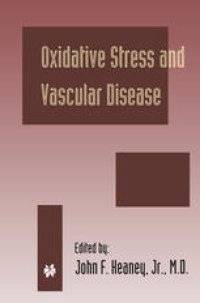
Ebook: Oxidative Stress and Vascular Disease
- Tags: Cardiology
- Series: Developments in Cardiovascular Medicine 224
- Year: 2000
- Publisher: Springer US
- Edition: 1
- Language: English
- pdf
One of the major biomedical triumphs of the post-World War II era was the defmitive demonstration that hypercholesterolemia is a key causative factor in atherosclerosis; that hypercholesterolemia can be effectively treated; and that treatment significantly reduces not only coronary disease mortality but also all cause mortality. Treatment to lower plasma levels of cholesterol - primarily low density lipoprotein (LDL) cholesterol - is now accepted as best medical practice and both physicians and patients are being educated to take aggressive measures to lower LDL. We can confidently look forward to important decreases in the toll of coronary artery disease over the coming decades. However, there is still uncertainty as to the exact mechanisms by which elevated plasma cholesterol and LDL levels initiate and favor the progression of lesions. There is general consensus that one of the earliest responses to hypercholesterolemia is the adhesion of monocytes to aortic endothelial cells followed by their penetration into the subendothelial space, where they differentiate into macrophages. These cells, and also medial smooth muscle cells that have migrated into the subendothelial space, then become loaded with mUltiple, large droplets of cholesterol esters . . . the hallmark of the earliest visible atherosclerotic lesion, the so-called fatty streak. This lesion is the precursor of the more advanced lesions, both in animal models and in humans. Thus the centrality of hypercholesterolemia cannot be overstated. Still, the atherogenic process is complex and evolves over a long period of time.
The purpose of this book is to provide the reader with an overview of oxidative stress as it pertains to vascular diseases. The first part of the book is designed to help the reader grapple with important issues such as: Precisely what is oxidative stress? What markers are available to assess oxidative stress? and What are the precise sources of oxidative stress and antioxidant defenses in the vasculature? With this information as background, the book goes on to address the major vascular disease syndromes for which there is good evidence that oxidative stress may be involved. The greatest body of evidence exists for atherosclerosis and, accordingly, this is the most extensive section. However, we have taken great care to try and provide the reader with objective evidence for the role of oxidative stress in other diseases such as diabetes, hypertension, and vascular remodeling. In each instance, the book is designed to provide a solid overview of the basic science data required to evaluate the role of oxidative stress. Animal data is then presented and finally, where applicable, the role of oxidative stress in human disease is discussed with the appropriate reference to epidemiologic data. The book is designed to appeal to both scientists and clinicians with an interest in vascular disease and its underlying pathophysiology.